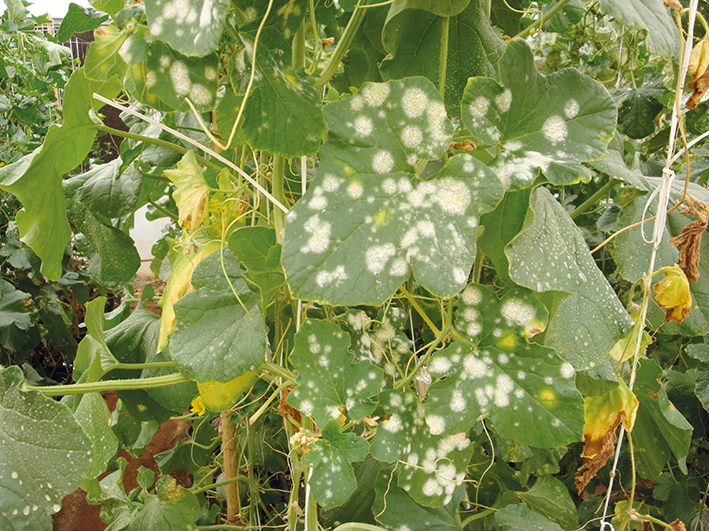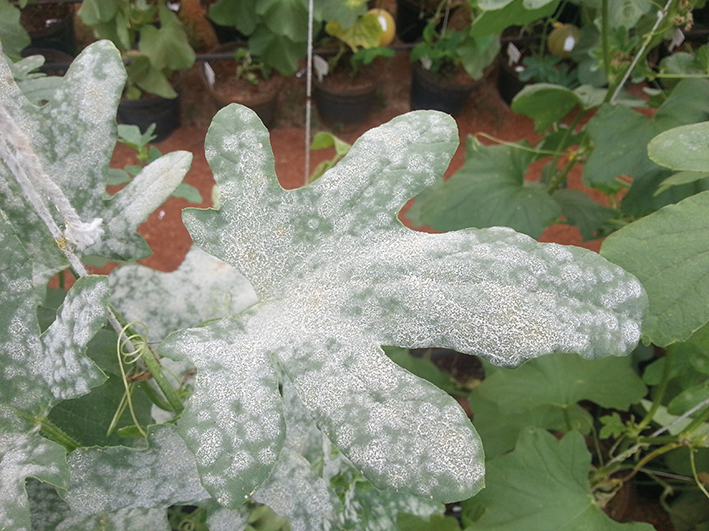What are the main problems encountered in sprayers?
Essential and basic care related to application rate, cleaning, decontamination and maintenance of sprayers are left aside, causing inefficiency in the operation,
The melon tree is susceptible to many pathogens, capable of causing important diseases in the crop, drastically reducing production and fruit quality, as well as making cultivation unfeasible in some regions or planting seasons. Among these diseases, melon powdery mildew stands out, one of the main diseases of the crop in Northeast Brazil and one of the most important worldwide. At least six species of pathogens have been identified as causal agents of the disease. However, the species Podosphaera xanthii (without. Sphaerotheca fuliginea) to Golovinomyces cichoracearum (without. Erysiphe cichoracearum) are the most relevant in the country. Podosphaera xanthii is the predominant species in the world and occurs most frequently in regions with a tropical and subtropical climate, while G. cichoracearum It predominates in regions with a temperate climate. In Brazil, only the presence of P. xanthii, until in 2012 the species G. cichoracearum was identified in protected crops in the state of Paraná.
Powdery mildew affects a large number of cultivated cucurbits, such as cucumber, watermelon, pumpkin, gourd, chayote and loofah, as well as wild plants. Podosphaera xanthii presents several known physiological races, which differ in their ability to infect different species of cucurbits or melon varieties. Studies have reported the predominance of races 1 and 2 of the pathogen in Brazil, while others have a more restricted distribution, such as race 3 reported in the Federal District and race 4 reported in the Federal District and more recently in São Paulo.
Powdery mildew occurs in practically all melon production regions, but epidemics of the disease are more intense in conditions of temperatures between 20°C and 25°C and low relative humidity, and its occurrence is very common in crops grown in a protected environment. . Pathogen conidia are easily spread by wind and, even in low humidity conditions, can germinate. As they are biotrophic fungi, which only survive in association with living hosts, the presence of other cultivated or wild host cucurbits located close to the cultivation area or in the area itself, they serve as a source of initial inoculum of the pathogens for successive or one-year cultivations. to each other or to new cultivation areas.

The disease occurs throughout the aerial part of the plant, such as leaves, petioles and stems, but old leaves are the most affected. Symptoms appear primarily on shaded and older leaves in the form of circular spots of lighter tones, which increase in size and are later covered by a powdery white mold (cottonous) predominantly on the upper surface of the leaves, formed by mycelium, conidiophores and conidia (spores) of the fungus. As the days go by, the spots increase in size (coalesce) and can cover the entire length of the leaf. As the disease progresses, the initially infected leaves and branches turn yellow and dry, taking on a brown hue. As the plant dies, the fruits suffer slight deformation, and also show reduced growth due to the compromise of the plant's photosynthetic area. Severely attacked plants lose vigor and their production is affected by the reduction in the number, size and quality of fruits, caused by the incidence of direct solar irradiation on the fruits and lower accumulation of soluble solids.
Preventive measures can be adopted to minimize the severity of the disease, such as avoiding planting in areas that receive winds, where cucurbits are cultivated, eliminating crop residues immediately after harvest and eliminating remaining host plants in the area or in areas adjacent to the cultivation area. Torrential rains or sprinkler irrigation contribute to disease control, as they can wash away conidia and damage conidiophores and hyphae.
Currently, chemical control is the most used by producers, and should be started when the first symptoms of the disease are noticed, which generally occur on the underside of the leaves or on the green branches. For chemical control of the disease, spraying with contact fungicides, mainly sulfur-based, alternated with systemic fungicides (triazoles and strobilurins) registered with the Ministry of Agriculture, Livestock and Supply (Mapa) for control of the disease in crops is recommended. . Applications of fungicidal sprays must be carried out in order to achieve maximum leaf coverage of the plants, such as the underside of the leaves and the lowest leaves of the plant, especially when using contact products. It is worth mentioning that the use of systemic fungicides is more efficient in controlling the disease, as it has a greater distribution when absorbed by plants, in addition to having a greater residual effect after application, requiring a smaller number of applications when compared to contact fungicides. . It is recommended to alternate fungicides from different groups, that is, with different modes of action, in order to avoid the risk of selecting pathogens resistant to fungicides.
The planting of resistant cultivars also contributes to reducing the disease, as is the case of the yellow melon “BRS Araguaia”, which is resistant to powdery mildew (Podosphaera xanthii) race 2, developed by Embrapa's melon breeding program. However, the application of fungicides may be necessary under conditions of high inoculum pressure, even in cultivars resistant to the disease.

Of African origin, melon (Cucumis melo L.) belongs to the Cucurbitaceae family with growing popularity in Brazil and around the world. Its largest worldwide consumption occurs in Europe, Japan and the United States. In Brazil, in the last five years, there has been an expansion of production of more than 500 thousand tons/year. In 2017, the country harvested 23 thousand hectares of melons and exported US$162 million, with Europe and the United States as the main buyers. Of the 540 thousand tons produced in 2017, the Northeast region is responsible for 95% of national production. While in the São Francisco Valley (BA/PE) small production focuses on domestic consumption, the largest producing region in Brazil (Rio Grande do Norte/Ceará) allocates almost 80% of its area to the international market. Melon occupies second place in the ranking of Brazilian fruits with the highest revenue generation and fourth in the world ranking.
Alexandre Augusto de Morais and Ricardo Borges Pereira, Embrapa Hortaliças, Brasília, DF
With each new edition, Cultivar Hortaliças e Frutas publishes a series of technical content produced by renowned researchers from all over Brazil, which address the main difficulties and challenges encountered in the field by rural producers. Through research focused on controlling the main pests and diseases in vegetable and fruit cultivation, the Magazine helps farmers in the search for management solutions that increase their profitability.

Receive the latest agriculture news by email